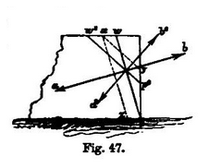plane of the wall) are perpendicular to the path of emergence.
The position of the point , or the distance down the quoin, at which the two adjacent fractures meet, apart from any variations caused by differences of masonry, &c., depends both upon the velocity, and the angle of emergence of this wave.

For referring to Fig. 47, if , be the path of emergence, referred to one of the walls, and , be the line of fracture therein corresponding, then as the mass thrown out is greater, as the velocity is so, and as the angle of fracture with the quoin is constant, while the emergence is so, it follows that if the velocity be reduced, the fracture will be somewhere as at , still parallel to , but higher up, and vice versa, and so for any other emergence: but if the velocity being the same, the angle of emergence vary, then, in order that the line of fracture may still continue perpendicular thereto, the point must ascend or descend along the quoin as with the path , producing the line of fracture , which, when it makes a very acute angle with the quoin, and therefore the angle of emergence small, and the velocity also great, may even follow back along the wall as to , so that the point , would fall below the base of the wall, if the lines of the fractures were produced.
In the Photog. No. 49, which gives a very good illustration of this class of fracture, as observed at Auletta, this was actually the case. In this view, one of the other large fissures, corresponding to and (Fig. 45) may











